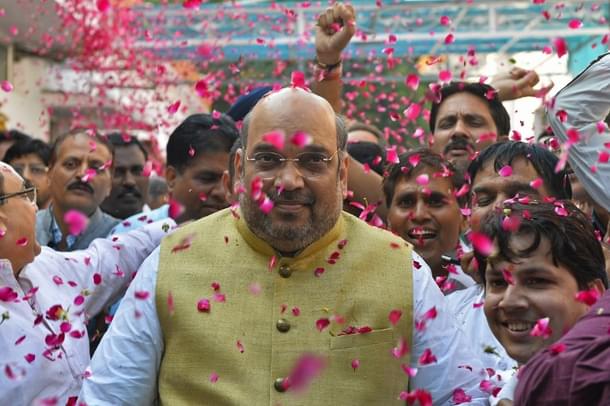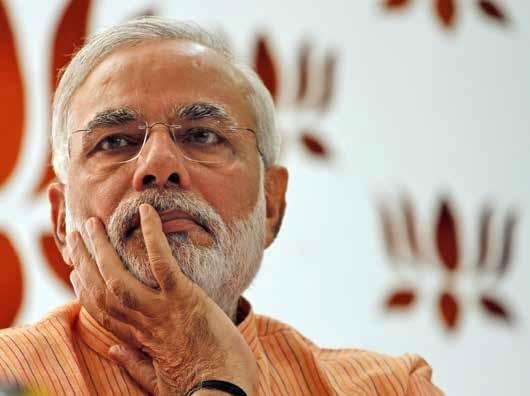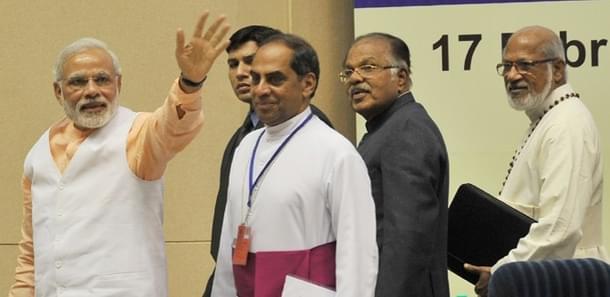Politics
Aspiration To Impatience
Madhu Purnima Kishwar
Jun 07, 2015, 11:14 PM | Updated Feb 11, 2016, 10:07 AM IST
Save & read from anywhere!
Bookmark stories for easy access on any device or the Swarajya app.


As all survey reports have shown, Modi deservingly remains the most popular leader and people’s first choice as PM. But many of his well-wishers are sounding alarm bells that his government’s performance doesn’t match its rhetoric. The concluding part of a two-part series.
The manner in which Narendra Modi has decided to cocoon himself contrasts sharply with how Sonia Gandhi built a power base for herself starting from total scepticism about her suitability for the top job. One of the first things she did after UPA’s assumption of power in 2004 was to co-opt several high profile do-gooders as her personal courtiers by creating a high powered National Advisory Council. With this one stroke, she managed to tie most of the NGO leaders as well as left-leaning academics and intellectuals to her apron strings. She sought out the likes of Amartya Sen as advisors and in turn a large body of intellectuals became willing courtiers.
They became intoxicated by their proximity to the UPA High Command and felt they had high stakes in this government. This entire spectrum became the most effective weapons in the Congress Party’s battle against the BJP. Even though the NAC was an unconstitutional body, none of the leftist intellectuals or activists objected because she made them stakeholders in the government. They also helped create a halo for Sonia Gandhi as someone who was pro-poor, pro-minorities, pro-all good causes. Even though the Congress ran a scam-ridden government, the leftist NGOs and intellectuals remained Sonia’s firm allies.
By contrast, far from creating new allies, Modi has studiously distanced himself from old allies like Arun Shourie, the Jethmalanis and numerous others who stood by him. And who has he surrounded himself with? Nameless, faceless bureaucrats and a couple of political favourites who are themselves lightweights.
We are told that Amit Shah has been meeting senior members of the teams that led the party’s social media campaign during the general elections to figure out ways to counter BJP’s losing edge on social media as well as improve the performance of party spokespersons in TV debates: “Look at the pinstripe suit controversy about the PM…we didn’t have a team to defend us,” said a senior party leader. (The Indian Express, March 31, 2015).
But the BJP high command better understand that far from readiness to ably defend the party, most of its well-wishers are sulking at Modi’s use-and-throw attitude. The kind of social media warriors that had once flocked to Modi can’t be hired for money. Even BJP stalwarts who are not part of the government are complaining about the “arrogance” and “inaccessibility” of Team Modi. The rank and file of BJP is highly disgruntled and feel their leaders have become too smug and arrogant and they don’t get a hearing even on legitimate issues.
The first response of citizens to arrogance of their rulers is despondency and sulk—which is what has happened to BJP cadre and supporters. But it takes only a few sparks to turn that despondency to rage, as the Congress party discovered to its dismay in May 2014.
The Prime Minister is seen on TV either touring abroad or receiving foreign heads of state, corporate honchos, or meeting socialites and film stars. In the last several months, one has never once seen him interacting with ordinary citizens. He only addresses them when he goes electioneering. But that is a one-way communication which doesn’t allow for the kind of rapport he once had with party workers and non-BJP volunteers. For instance, when Modi launched his Swachh Bharat campaign with much fanfare, he announced famous cricket stars, corporate leaders, Bollywood and TV actors and other celebrities as brand ambassadors.
All of these worthies can at best indulge in token gestures. But to be really effective, he needed to enthuse and mobilize BJP municipal councilors and party cadres to take charge of their respective neighbourhoods or villages. But all we witnessed was farcical photo-ops by Delhi BJP leaders without any involvement of rank and file. Had he not unceremoniously dumped CAG, Friends of BJP and scores of other teams of volunteers who were ready and keen to play a creative role in transforming India under his leadership, today Modi could have counted on a massive force of dedicated and talented citizens to make the Clean India campaign a much greater success than it seems to have proved thus far.
It’s no better with other ministers in the Cabinet. They too are neither accessible nor reaching out to people. While Amit Shah’s achievement of enrolling 11 crore members of BJP is indeed laudable, these new recruits don’t seem to have the kind of motivation, energy and talent that the spontaneously emerged Modi support groups attracted.

The astounding defeat meted out by voters to BJP in the Delhi election is a sure sign of demoralization of BJP cadre and noticeable erosion of non-BJP support base. The PM had announced with much aplomb that he would be accessible and that people should send him their inputs for improving governance. But many who have taken that invitation seriously tell me that they never even get an acknowledgement, leave alone any serious follow up. Letters to the PM by eminent citizens or requests for appointment are also not answered. Nor is the PM communicating effectively to the people through the media. It’s Jaitley who seems to be the PM’s talking face most of the time.
Inadequate Response to Agrarian Crisis
Similarly, his response to the agrarian crisis on account of untimely rains and hail storms has been far from energetic. As farm policy expert Ashok Gulati has pointed out, in this day and age of technology you can use satellite imagery and drones to assess crop damage and get the computerized data for each farm within hours. This can be easily tied up with the Aadhar card system to provide speedy compensation to farmers. This job should not have been left to the corruption-friendly and inefficient patwari system. The relief money should have reached the farmers with the same speed with which the PM responded to the Nepal disaster.
At a personal level too, it was important for Modi to be seen interacting with farmers and coming up with innovative schemes that gave them hope. But his avoiding to do so is both puzzling and disappointing. No doubt, the agrarian crisis has been inherited from the previous Congress regimes. In Gujarat, Modi gave the highest priority to rejuvenating agriculture. But as PM, one doesn’t see in him that sense of urgency about reviving the health of farm sector.

Thus far, there is very little sign of the Modi government introducing noteworthy changes in farm policy that need to be brought in on a war footing. The amount of money (Rs 5,000 crore) earmarked for irrigation is a fraction of the Rs 50,000 crore required for the job. The promise of making India a unified market for farm produce has not yet been honoured. None of the business deals made by Modi in foreign countries he visited pertain to agriculture. No major initiative in research and development for the farm sector has taken off. India has a lot to learn from China on this account because the Chinese economic growth miracle has been built on the foundation of liberalisation and massive investment in the farm sector. Modi used the same formula with great success in Gujarat.
As Gujarat chief minister, he put an extraordinary amount of time, energy and thought into bringing new vibrancy and prosperity into the farm sector by investing heavily in water harvesting, drip irrigation, soil health cards, reaching the best of seeds, pesticides, fertilizers and other inputs to farmers’ doorstep. The state bureaucracy and agricultural scientists were mobilized to serve the farm sector in a proactive manner. The markets for agricultural produce were reformed and numerous incentives provided to farmers to undertake new experiments. Modi himself interacted extensively with the farmers throughout the year but especially during Krishi Utsavs. He had his ear to the ground and personal live contact with farmers so that he responded with speed to the problems and challenges faced by them.
Not surprising then that the farm sector grew at 9-10 per cent per annum during Modi’s tenure as CM of Gujarat, whereas in the rest of the country it was stagnating at 2-3 per cent. Even though Modi’s critics tried to project him as someone who only served corporate interests, farmers in Gujarat saw in him a caring friend and well-wisher.
(continued on next page)
It is a mystery why as PM he has made no attempt to engage with farm leaders directly. That space has been ably occupied by Sonia Gandhi and other opposition leaders. His one way communication on this issue through his “Mann ki Baat” radio programme is not a substitute for direct two-way engagement.
The Land Acquisition Bill Stalemate
It’s a great puzzle why the Modi government has gone about trying to amend the Land Acquisition Act, 2013 in such a ham handed manner. In the process, it has managed to infuse new life into the Opposition parties which were in total disarray. Congress can now piously claim that they were the real defenders of farmers whereas the Modi government wants to snatch away their only asset in the interest of corporates. Modi has gifted them a difficult convenient issue to tar him with an anti-poor and pro-rich brush.
In his defense, Modi says that chief ministers of many of the opposition-ruled states had approached him to bring about certain urgently required amendments to this law. If that was the case, the road to reform was easy and simple. In the spirit of his own slogan of “cooperative federalism”, all he needed to do was to set up a committee of chief ministers, headed by a non-BJP chief minister to present him a list of consensually agreed upon amendments. In that case, no major party could have opposed the proposed changes.
Land is in any case a state subject and chief ministers are most affected if they cannot invite industrial investments or undertake development projects. Most states have in any case brought about the required amendments to the draconian and colonial-minded 1894 Land Acquisition Act. Those states that are serious about industrialization, as for example Gujarat, have been able to acquire land without too much trouble. The chief ministers would have gladly helped the government in fine tuning the land law had he made them take the lead.
It is beyond comprehension why instead, the PM chose the confrontational route by bringing in an Ordinance. Another instance of Jaitley wisdom? Leave alone build a cross-party consensus, even within PM’s own Parivar, there is stiff resistance to the amendments with prominent voices within the RSS and the farmers front of the BJP—the Bharatiya Kisan Sangh—openly opposing the Ordinance. If he can’t carry his own political family with him, how does he expect to carry the opposition with him?
PM Modi’s inept handling of Land acquisition laws contrasts sharply with the way as chief minister he handled with great dexterity the issue of land acquisition for industrial purposes and infrastructure projects in Gujarat. To begin with, the state government did not go about forcibly acquiring land and came to be known for devising the best land policy in the country. The Gujarat Industrial Development Corporation negotiates the terms of sale directly with the farmers instead of forcibly taking over their land. Moreover farmers are paid far higher than the market price. But in many instances, industrialists have negotiated land prices directly with the farmers without requiring help from the state. This is largely because the Gujarat government during Modi’s tenure as CM encouraged setting up of industries in the desert regions and on unproductive lands by providing world class infrastructure – well-built all-weather roads, 24×7 power supply, assured water and related requirements along with tax concessions in those regions.
In such regions, land was available for a song because it was unproductive and in large parts barren. Therefore, farmers were only too glad to sell it. But as industries started coming up in such areas, the land prices shot up dramatically and made subsistence farmers wealthy overnight. That is why there were very few instances of farmer resistance to giving lands for industries. But within months of becoming prime minister, Modi is widely perceived as being “anti-farmer” on account of the rough and uncaring manner in which he tried to push through amendments to the Land Acquisition Act.
Message from BJP’s Humiliating Defeat in Delhi
The crushing defeat meted out to BJP in Delhi was the first serious wake up-call that PM Modi could not take his popular support for granted. The Delhi fiasco was easily avoidable had BJP not failed to initiate even the most basic changes needed to make Delhi feel the beginnings of “acchhe din” instead of smugly counting on the “Modi wave”. Those nine months should have been used in plucking the low hanging fruits in order to win over Delhi votes.
For instance, Modi could easily have motivated BJP municipal councilors to put all their energy into making Delhi a role model for Swacchh Bharat within six months. Likewise, he could have pushed them to curb corruption and bring efficiency in the MCD’s functioning. But apart from some municipal councillors doing the silly nautanki of holding the broom for the benefit of news cameras, we did not witness the slightest improvement in municipal governance. Hence the backlash.
Another low hanging fruit was to replicate in Delhi the major reforms in policing that were put in place in Surat by Police Commissioner Rakesh Asthana within a record 4-5 months. The cutting-edge technology put to use by Asthana in order to bring about efficiency and accountability are visible on the ground with CCTV cameras covering the entire city backed by a 24×7 high-tech monitoring centre. The system brought down the crime rate without fudging figures. Its replication in Delhi would have assured Delhi citizens that Modi is serious in delivering on his oft-repeated promise of bringing greater security and safety for women. The government could have also easily improved lighting on the city streets and other public spaces to act as a deterrent for criminals. All this could be executed without any hitch since Delhi was under Lt Governor’s rule and the LG is directly responsible to the Union Home Minister.
To top it all, candidates were announced at the last minute and a political novice from outside imposed as a CM candidate. Was it smugness that made Modi neglect Delhi before the crucial Assembly elections? On the other side, AAP was out campaigning door to door for months on end while BJP cadre was either sulking or sitting complacently at home. No wonder the Delhi electorate gave Modi a resounding defeat to drive home the message that they should not be taken for granted.
Neglect on Administrative Reforms
Modi had promised far reaching administrative reforms and synergy between different ministries by breaking silos. He did this well in Gujarat. But as PM, even baby steps have not been taken in this direction. For instance, Ministries of Agriculture, Rural Development, Panchayati Raj, Irrigation and Food Processing should have been clubbed under one ministry with dedicated teams of experts for each of these areas working in close coordination.
Similarly the HRD ministry should have been merged with Ministries of Culture and Skill Development. But nothing of the sort happened. The systemic reforms needed to bring vibrancy into the economy and service delivery to people’s doorstep, as in Gujarat, have yet to take off. As far as police and judicial reforms are concerned, we haven’t yet witnessed even modest steps in that direction even though Modi knows from the Gujarat experience that improvements in the law and order situation and a robust dispute resolution system are crucial to reviving economic health.
On the Corruption Front
Even though as PM Modi has definitely succeeded in curbing big ticket corruption and scams that emanate at the ministerial level by keeping a close watch on his cabinet colleagues and bureaucrats, however, for the ordinary citizen his daily interaction with government machinery is still riddled with harassment and extortion. To be fair to Modi, he cannot possibly keep a watch over municipal or thana level officials. But people do expect from the Modi government a total overhaul of the system of governance from top to bottom. For that we have to have more patience. However, going slow on high profile cases such as Robert Vadra land deals or the National Herald case involving Sonia Gandhi sends a very negative message.
Here are two telling examples that raise serious misgivings about the BJP government’s credentials with regard to corruption by bigwigs of the previous regime. The PM had let it be known that Ashok Khemka, the IAS officer who risked his life and career in exposing Robert Vadra’s fraudulent land deals in Haryana, would be brought to the PMO. But Arun Jaitley allegedly put his foot down and got that decision cancelled. Worse still, the chargesheet filed against Khemka by the Congress government has not been withdrawn by the new BJP government in Haryana. What’s more, he has been humiliated further with a punishment posting where he has no work, no staff and not even proper office space.
Similarly, the PM had promised that justice would be done to Sanjay Shrivastav, the Income Tax Commissioner who caught the Chidambram-NDTV hawala scam. He too was hounded out of his job by Chidambram with numerous false cases filed against him when the UPA was in power. Here too Mr Jaitley has ensured that even his chargesheet has not been withdrawn. He continues to be on “compulsory wait”. The rules permit an officer to draw his salary while on “compulsory wait” but Shrivastav continues to be deprived of his posting and salary since April 2013.
Khemka and Srivastav are not just two wronged individuals but both became symbols of the movement to curb corruption. If the BJP government continues to persecute them, despite the PM’s public commitment to the contrary, it sends a very sorry message.
It is the same story with the promise regarding the return of black money stashed in foreign accounts. This was a major electoral promise of Modi but there is very little follow-up to fulfil that promise. The draconian law recently passed by the Lok Sabha to punish black money hoarders is a poor substitute for tracking the loot money already stolen out of India.
(continued on next page)
Modi’s erstwhile allies, Baba Ramdev and Ram Jethmalani are openly fuming at the blatant U-turns taken by the Finance Minister on the black money issue. Thus far they have lashed out only at Arun Jaitley. Instead of assuaging their fears, Modi has preferred to cut them off. This only confirms the doubts of sceptics that Jaitley has managed to steer the black money probe in the direction of protecting his friends in the Congress. This bodes ill for the Modi government. Another glaring example involves the massive scam exposed by three times BJP MP Kirti Azad in the management of the Delhi State Cricket Board while it was under the President-ship of Arun Jaitley. Leading cricketers have been pleading with Modi to take action on the basis of serious indictments by official inquiry reports. But the PM has chosen to stonewall that demand.
Other Disappointments
Another disappointment is the weak-kneed fashion in which Modi has responded to motivated charges by the Christian community leaders ably assisted by “secular parties” that minorities are under attack and fear being crushed by the BJP government. Almost all the alleged attacks on churches and other Christian institutions have turned out to be cases of petty burglary or property disputes or random incidents involving some crackpot throwing a stone or two at a church.

In one case, it was a case of short circuit leading to a minor fire in a West Delhi church. The culprits in the alleged rape of a nun in a West Bengal Convent turned out to be Bangladeshi miscreants. In one case, police said it was a case of self-inflicted damage. The hysteria built around these phony cases is clearly part of a well orchestrated move to project Modi in devilish light both within the country and abroad. Instead of swiftly coming out with a well-investigated white paper on the alleged attacks, Modi went into defensive mode. It was mainly social media activists who exposed all this mischief by circulating the findings of police inquiry reports which the mainstream media deliberately underplayed. While it was indeed required that foul-mouthed loose cannons like Sadhavi Niranjana be firmly disciplined, the Modi government should have also communicated to mischief mongers among the Christian community that hysteria and phobia created on the basis of false allegations would not be tolerated.
Likewise, on the Ghar Wapsi issue, while farcical attempts at reconversion by fringe Hindu groups needed to be checked with a firm hand, the BJP developed cold feet in asserting its original eminently reasonable position that either all conversions be banned or else Hindu groups be allowed the same freedom to win over converts that Christians and Muslims routinely exercise. This contentious issue cannot be resolved using the phony secular prism of the Congress or Left parties.
Finally, BJP’s capitulation in dealing with the PDP in Kashmir has come as a jolt to its own core constituency. While Modi’s willingness and ability to craft a coalition with a Muslim majority party like PDP, displayed great maturity and political astuteness, but committing in their Common Minimum Programme, that the secessionist Hurriyat would be included in consultations as an integral stakeholder while seeking a permanent solution to Kashmir problem is a big blunder.
This amounts to yielding far more ground to Pak-backed secessionists and bestowing them far greater credibility than even the flip-flop-prone Congress ever did. No democracy can afford to make self-proclaimed proven terrorists stakeholders in its decision making. Also, the BJP negotiators surprisingly accepted the position of a junior partner vis-a-vis PDP when it came to power sharing in the Cabinet though their vote share was much larger than the PDP share and the number of seats nearly the same. This too has annoyed BJP rank and file in the Jammu region. On the other hand, the active engagement expected of the PM in putting J&K on fast track mode of economic development hasn’t happened.
Finally, the government’s inability to fill in key posts such as that of CVC, CIC gives his opponents a very strong handle against Modi. Apart from these high profile vacancies, hundreds of positions lie vacant especially under the HRD ministry despite a full year of NDA in power. It strengthens the popular prejudice that BJP doesn’t have talented people under its umbrella and therefore, has failed to replace Congress loyalists.
Consequently, the Modi government is unable to undertake the much-needed course correction in many key areas. By contrast, when Congress comes to power, it doesn’t take more than a day or two to post its own people in all key positions. Modi could easily have made up for talent deficit within his own party by recruiting new people from the enormous talent pool that gravitated towards him in the run up to the Lok Sabha elections. Someone like Prashant Kishore who gave up his high flying career to work for Modi starting 2011 and founded CAG in 2013 among other initiatives should have been included in the government solely on the strength of his enormous talent and contribution. But Modi is supposed to have cast him aside rudely as he did numerous others who worked for him. In this one year, Modi has lost many valuable friends without gaining any new allies.
Even from within the BJP pool, keeping out the likes of Arun Shourie is giving the impression that wants to surround himself with those who can never dare script their own role but will dutifully read out the script assigned to them. It’s unfortunate that BJP has not yet developed the tradition of nurturing high worth intellectuals and academics. Nor has it learnt to embrace talent from outside, something the Congress party does very ably. It has not done so even in states where it has been in power for sufficiently long periods. Even Modi failed to do so in Gujarat even though as CM he paid far more attention to the education sector than he is doing as PM. They will continue to suffer from talent deficit if they don’t pay serious attention to this domain.
To Conclude
As all survey reports have shown, Modi deservingly remains the most popular leader and people’s first choice as PM. But many of Modi’s well wishers are sounding alarm bells that his governments performance doesn’t match its rhetoric.
Barring perhaps Jawaharlal Nehru, no other politician in India has fired the imagination of the aspirational India as did Modi. Even the appeal of Jay Prakash Narayan was far more limited despite his promise of “total revolution.” V.P. Singh also rode to power on the strength of popular sentiment but his promises were very modest just as his overall vision was far from inspirational. When he failed, not too many people shed any tears for him.
But people put serious trust in Modi’s promise of total transformation of power structures and harnessing of its youth power in order to lead India towards occupying a pride of place in the comity of nations. But “Aspirational India” that Modi appealed to is also “Impatient India” and if frustrated can easily become “Unforgiving India” as was demonstrated by the unprecedented drubbing given to BJP in the 2015 state assembly elections of Delhi.
Madhu Purnima Kishwar is Maulana Azad National Professor, ICSSR, and the founder of human rights organisation, MANUSHI.





